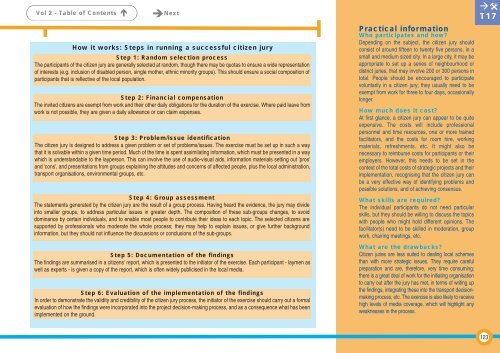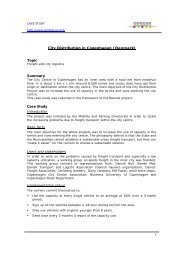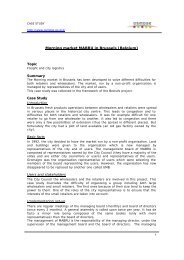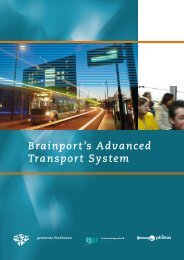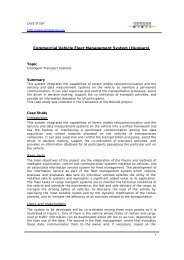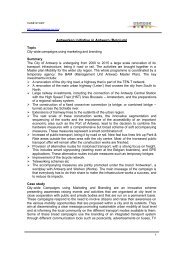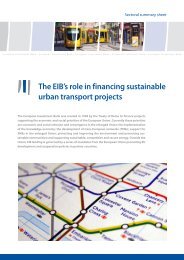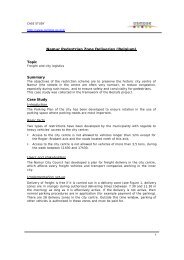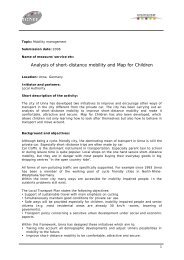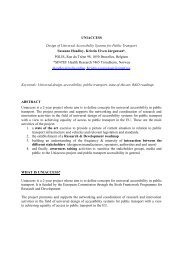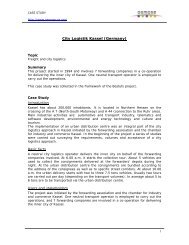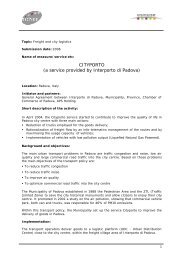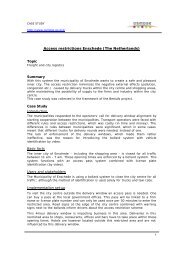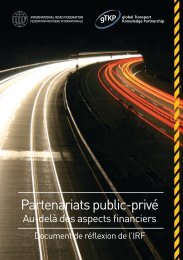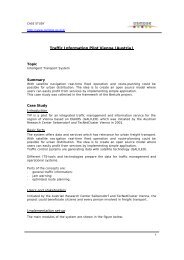Successful transport decision-making - Osmose
Successful transport decision-making - Osmose
Successful transport decision-making - Osmose
Create successful ePaper yourself
Turn your PDF publications into a flip-book with our unique Google optimized e-Paper software.
Vol 2 - Table of Contents Next Practical information<br />
Who participates and how?<br />
How it works: Steps in running a successful citizen jury<br />
Step 1: Random selection process<br />
The participants of the citizen jury are generally selected at random, though there may be quotas to ensure a wide representation<br />
of interests (e.g. inclusion of disabled person, single mother, ethnic minority groups). This should ensure a social composition of<br />
participants that is reflective of the local population.<br />
Step 2: Financial compensation<br />
The invited citizens are exempt from work and their other daily obligations for the duration of the exercise. Where paid leave from<br />
work is not possible, they are given a daily allowance or can claim expenses.<br />
Step 3: Problem/issue identification<br />
The citizen jury is designed to address a given problem or set of problems/issues. The exercise must be set up in such a way<br />
that it is solvable within a given time period. Much of the time is spent assimilating information, which must be presented in a way<br />
which is understandable to the layperson. This can involve the use of audio-visual aids, information materials setting out 'pros'<br />
and 'cons', and presentations from groups explaining the attitudes and concerns of affected people, plus the local administration,<br />
<strong>transport</strong> organisations, environmental groups, etc.<br />
Step 4: Group assessment<br />
The statements generated by the citizen jury are the result of a group process. Having heard the evidence, the jury may divide<br />
into smaller groups, to address particular issues in greater depth. The composition of these sub-groups changes, to avoid<br />
dominance by certain individuals, and to enable most people to contribute their ideas to each topic. The selected citizens are<br />
supported by professionals who moderate the whole process; they may help to explain issues, or give further background<br />
information, but they should not influence the discussions or conclusions of the sub-groups.<br />
Step 5: Documentation of the findings<br />
The findings are summarised in a citizens' report, which is presented to the initiator of the exercise. Each participant - laymen as<br />
well as experts - is given a copy of the report, which is often widely publicised in the local media.<br />
Step 6: Evaluation of the implementation of the findings<br />
In order to demonstrate the validity and credibility of the citizen jury process, the initiator of the exercise should carry out a formal<br />
evaluation of how the findings were incorporated into the project <strong>decision</strong>-<strong>making</strong> process, and as a consequence what has been<br />
implemented on the ground.<br />
Depending on the subject, the citizen jury should<br />
consist of around fifteen to twenty five persons, in a<br />
small and medium sized city. In a large city, it may be<br />
appropriate to set up a series of neighbourhood or<br />
district juries, that may involve 200 or 300 persons in<br />
total. People should be encouraged to participate<br />
voluntarily in a citizen jury; they usually need to be<br />
exempt from work for three to four days, occasionally<br />
longer.<br />
How much does it cost?<br />
At first glance, a citizen jury can appear to be quite<br />
expensive. The costs will include professional<br />
personnel and time resources, one or more trained<br />
facilitators, and the costs for room hire, working<br />
materials, refreshments. etc. It might also be<br />
necessary to reimburse costs for participants or their<br />
employers. However, this needs to be set in the<br />
context of the total costs of strategic projects and their<br />
implementation, recognising that the citizen jury can<br />
be a very effective way of identifying problems and<br />
possible solutions, and of achieving consensus.<br />
What skills are required?<br />
The individual participants do not need particular<br />
skills, but they should be willing to discuss the topics<br />
with people who might hold different opinions. The<br />
facilitator(s) need to be skilled in moderation, group<br />
work, chairing meetings, etc.<br />
What are the drawbacks?<br />
Citizen juries are less suited to dealing local schemes<br />
than with more strategic issues. They require careful<br />
preparation and are, therefore, very time consuming;<br />
there is a great deal of work for the initiating organisation<br />
to carry out after the jury has met, in terms of writing up<br />
the findings, integrating these into the <strong>transport</strong> <strong>decision</strong><strong>making</strong><br />
process, etc. The exercise is also likely to receive<br />
high levels of media coverage, which will highlight any<br />
weaknesses in the process.<br />
<br />
T17<br />
123


